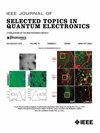Spin Mechanisms in Gd-Doped GaN Implanted With Oxygen/Carbon at Room Temperature
IF 5.1
2区 工程技术
Q1 ENGINEERING, ELECTRICAL & ELECTRONIC
IEEE Journal of Selected Topics in Quantum Electronics
Pub Date : 2025-01-27
DOI:10.1109/JSTQE.2025.3534663
引用次数: 0
Abstract
Gadolinium-doped gallium nitride implanted with oxygen and carbon show carrier-mediated spin mechanisms at room temperature. As-grown Gd-doped GaN grown by metal-organic chemical vapor deposition using a tris(cyclopentadienyl) gadolinium precursor shows Ordinary Hall Effect and no ferromagnetism at room temperature. Upon O or C implantation in Gd-doped GaN, Anomalous Hall Effect that is indicative of carrier-mediated spin and ferromagnetism is observed. A good crystal quality is maintained even after implantation. O and C favor interstitial sites and occupy deep-level acceptor-type states in Gd-doped GaN. Room-temperature spin and ferromagnetism that is induced by gadolinium in Gd-doped GaN is activated by O and C that occupy interstitial sites. Carrier-mediated mechanism for spin functionalities shows potential for the control and manipulation of spin as a quantum state in gallium nitride. This makes GaGdN:O/C a potential semiconductor material base of interest for room temperature spintronics and quantum information science applications. In this paper, doping of O and C in Gd-doped GaN using ion implantation, structural characterization using X-ray diffraction, and spin-related measurement using Advanced Hall Effect are investigated, and corresponding discussions are made.室温下氧/碳注入gd掺杂GaN的自旋机制
在室温下,氧和碳注入的掺钆氮化镓表现出载流子介导的自旋机制。以三(环戊二烯基)钆为前驱体,采用金属有机化学气相沉积法生长的掺钆氮化镓在室温下表现出普通的霍尔效应和无铁磁性。在氮化镓中注入O或C后,观察到载流子介导的自旋和铁磁性的反常霍尔效应。即使在植入后也能保持良好的晶体质量。在掺杂镓的GaN中,O和C倾向于间隙位并占据深层受体型态。钆掺杂GaN的室温自旋和铁磁性是由占据间隙位的O和C激活的。载流子介导的自旋功能机制显示了氮化镓中自旋作为量子态的控制和操纵的潜力。这使得GaGdN:O/C成为室温自旋电子学和量子信息科学应用的潜在半导体材料基础。本文采用离子注入的方法研究了O和C在gd掺杂GaN中的掺杂、x射线衍射的结构表征和先进霍尔效应的自旋相关测量,并进行了相应的讨论。
本文章由计算机程序翻译,如有差异,请以英文原文为准。
求助全文
约1分钟内获得全文
求助全文
来源期刊

IEEE Journal of Selected Topics in Quantum Electronics
工程技术-工程:电子与电气
CiteScore
10.60
自引率
2.00%
发文量
212
审稿时长
3 months
期刊介绍:
Papers published in the IEEE Journal of Selected Topics in Quantum Electronics fall within the broad field of science and technology of quantum electronics of a device, subsystem, or system-oriented nature. Each issue is devoted to a specific topic within this broad spectrum. Announcements of the topical areas planned for future issues, along with deadlines for receipt of manuscripts, are published in this Journal and in the IEEE Journal of Quantum Electronics. Generally, the scope of manuscripts appropriate to this Journal is the same as that for the IEEE Journal of Quantum Electronics. Manuscripts are published that report original theoretical and/or experimental research results that advance the scientific and technological base of quantum electronics devices, systems, or applications. The Journal is dedicated toward publishing research results that advance the state of the art or add to the understanding of the generation, amplification, modulation, detection, waveguiding, or propagation characteristics of coherent electromagnetic radiation having sub-millimeter and shorter wavelengths. In order to be suitable for publication in this Journal, the content of manuscripts concerned with subject-related research must have a potential impact on advancing the technological base of quantum electronic devices, systems, and/or applications. Potential authors of subject-related research have the responsibility of pointing out this potential impact. System-oriented manuscripts must be concerned with systems that perform a function previously unavailable or that outperform previously established systems that did not use quantum electronic components or concepts. Tutorial and review papers are by invitation only.
 求助内容:
求助内容: 应助结果提醒方式:
应助结果提醒方式:


